Abstract
We measured the portal circulatory hemodynamic parameters in 10 cirrhotic patients with portal hypertension and esophageal varices to determine the significance of esophageal variceal pressure. In 4 patients (group I), the temporary portal vein occlusion produced significant elevations in both the esophageal variceal pressure and the portal venous pressure. The results of the portal circulatory hemodynamic assessment in this group were consistent with the predominance of the backward flow mechanism. In the remaining 6 patients (group 11), however, portal vein clamping resulted in a slightly increased esophageal variceal pressure with an enormous increase in the portal pressure. The forward flow mechanism thus appeared to be predominant in group II. In other words, the results of the pressure measurements were consistent with the functional separation of the hemodynamics in the esophageal varices and portal trunk in group 11 and the functional hemodynamic continuity in group I. This functional separation between the esophageal varices and the portal trunk in group II might therefore have resulted from the increased blood flow in the lesser splanchnic region.
Similar content being viewed by others
References
Bandoh T, Mitarai Y, Kitano S, Yoshida T, Kobayashi M (1994) Clinical significance of esophageal variceal pressure in patients with esophageal varices. J Hepatol 21:326–331
Rigau J, Bosch J, Bordas JM, Navasa M, Mastai R, Kravetz D, Bruix J, Fen F, Rodes J (1989) Endoscopic measurement of variceal pressure in cirrhosis: Correlation with portal pressure and variceal hemorrhage. Gastroenterology 96:873–880
Gertsch P, Bohnet J, Mosimann R (1983) Endoscopic nonaggressive assessment of oesophageal variceal pressure compared with wedged hepatic venous pressure in alcoholic liver cirrhosis. Endoscopy 15:101–103
Dawson J, Gertsch P, Mosimann R, West R, Elias E (1985) Endoscopic variceal pressure measurements: Response to isosorbide dinitrate. Gut 26:843–847
Sarin SK, Sethi KK, Nanda R (1987) Measurement and correlation of wedged hepatic, intrahepatic, intrasplenic and intravariceal pressures in patients with cirrhosis of liver and non-cirrhotic portal fibrosis. Gut 28:260–266
Japanese Research Society for Portal Hypertension (1992) The general rules for recording endoscopic findings on esophagogastric varices (1991) (in Japanese). Acta Hepatol Jpn 33:277–281
Inokuchi K, Beppu K, Koyanagi N, Nagamine K, Hashizume M, Iwanage T, Sugimachi K (1984) Fifteen years' experience with left gastric venous caval shunt for esophageal varices. World J Surg 8:716–721
Mitarai Y, Kobayashi M, Yoshida T, Kim YI (1989) Changes in gastric mucosal blood flow after surgical therapy for oesophageal varices. J Gastroenterol Hepatol [Suppl] 1:85–87
Yoshida T, Mitarai Y, Kobayashi M (1990) Role of glucagon in gastric hyperdynamic circulation of cirrhotic portal hypertension (in Japanese with English abstract). Nippon Shokakigeka Gakkai Zasshi (Jpn J Gastroenterol Surg) 23:1830–1837
Koyanagi N, Inokuchi K, Nakayama S, Sakata H, Beppu K (1981) Decreased arteriovenous flow resistance in the left gastric venous area in cirrhotic patients. Fur J Clin Invest 11:355–359
Vorobioff J, Bredfeldt JE, Groszmann RJ (1984) Increased blood flow through the portal system in cirrhotic rats. Gastroenterology 87:1120–1126
Benoit JN, Womack WA, Hernandez L, Granger DN (1985) “Forward” and “backward” flow mechanisms of portal hypertension. Relative contributions in the rat model of portal vein stenosis. Gastroenterology 89:1092–1096
Aoki H, Hasumi A, Shimazu M (1988) The hemodynamics of esophago-gastric varices: Significance of esophago-gastric arterial inflow in their formation. In: Idezuki Y (ed) Treatment of esophageal varices. Elsevier, Amsterdam, pp 315–328
Futagawa S, Nakanishi R, Nishimura Y, Sugiura M (1988) Angiographic study of hemodynamics in portal hypertension. In: Idezuki Y (ed) Treatment of esophageal varices. Elsevier, Amsterdam, pp 355–359
Bosch J, Bordas JM, Rigau J, Viola C, Mastai R, Kravetz D, Navasa M, Rodes J (1986) Noninvasive measurement of the pressure of esophageal varices using an endoscopic gauge: Comparison with measurements by variceal puncture in patients undergoing endoscopic sclerotherapy. Hepatology 6:667–672
Polio J, Groszmann RJ (1986) Hemodynamic factors involved in the development and rupture of esophageal varices: A pathophysiologic approach to treatment. Semin Liver Dis 6:318–331
Author information
Authors and Affiliations
Rights and permissions
About this article
Cite this article
Yoshida, T., Bandoh, T., Kitano, S. et al. The significance of esophageal variceal pressure in patients with cirrhosis. Surg Today 27, 197–201 (1997). https://doi.org/10.1007/BF00941644
Received:
Accepted:
Issue Date:
DOI: https://doi.org/10.1007/BF00941644




